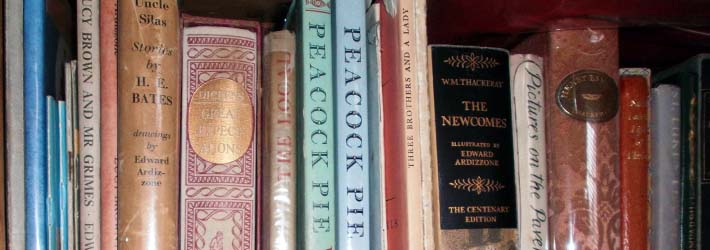Month 2: Scholar’s view

Curator and Collector
Brian Alderson has curated many book exhibitions and looking through the catalogues of these exhibitions it struck me that curating is a form of collecting too. It involves bringing together – not necessarily buying of course – a collection of books to illustrate a particular story. Collecting too involves selection. What to select? Books. What sort of books? Books for children. But that is only the beginning of the process. Brian’s collection is not a random collection of any children’s books that have caught his eye. Within the larger collection are groups of books which are linked in different ways that illustrate aspects of the history of children’s books. Often the links are multiple and intersect. During the three months of this project we have been shown many books, but they amount to only a small selection of the whole collection. Selection is a key word here. Frequently what Brian has shown us has been either a starting point for a conversation about a particular aspect of children’s book history or has stemmed from a discussion which he has then illustrated by showing us a selection of books. In either case, whether we have seen three books or thirty, they have been chosen to illustrate a particular point.
Different Sorts of Collections
For example: on one visit there is a table covered in books which at first glance seem to have little in common with each other. In fact the connection is straightforward: all the books are illustrated by the same illustrator – John Lawrence – and are gathered on the table for Brian to do research on Lawrence for a talk which he is giving at Newcastle University. This is a basic way of organising a collection. Equally it could form the starting point for an exhibition on Lawrence.
Another example is less obvious and shows how specialist knowledge comes into play in order to make subtle connections and hunt down links in a chain. This mini-collection is three copies of the same book. The book is The Fables of Aesop and Others translated into human nature, with illustrations by Charles H Bennett. The three copies have different publication dates in the second half of the nineteenth century. Read Brian's description of one copy of The Fables of Aesop.
Why three versions of the same book? It turns out that they have differences which make them interesting for what they reveal about the printing of illustrations at this time. All three books have the same illustrations in the form of [engraved] plates by Charles Bennett. In one copy the plates are in black and white; in another the plates have been hand-coloured; in the third they are printed [in colour]. The three different copies tell a tiny part of the story of children’s book publishing during the 1850s, 60s and 70s. They show that illustrations came in these three forms. [different prices?] They also form part of the story of the publishing history of Aesop’s Fables. This has been the subject of an Alderson exhibition held at Seven Stories, National Centre for Children’s Books in which he traces the development of publications of Aesop’s fables through the centuries by showing a large selection of examples.
Curating exhibitions is an art and a discipline involving academic knowledge but presented using the ability to distil that knowledge into a narrative which is visually and intellectually engaging. An exhibition may be visited by fellow experts or by interested laypeople and there must be something for everyone. Where a catalogue is involved, this can often be a considerable work of scholarship in its own right, providing a valuable work of reference beyond simply being a guide to the exhibition for its duration.
